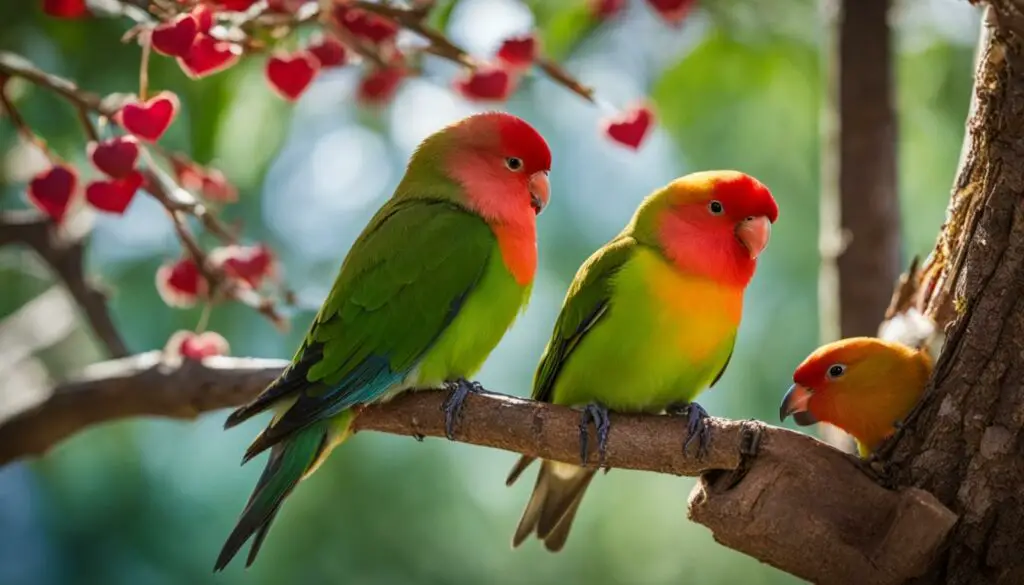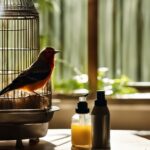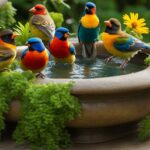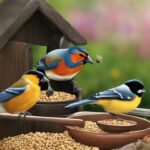Lovebirds are fascinating creatures with unique bonding and behavior traits. As an owner, it’s essential to understand these characteristics to provide a happy and fulfilling life for your feathered friend.
Lovebird bonding and behavior are crucial aspects of their well-being. These intelligent and affectionate birds thrive when they have a strong bond with their mate or a dedicated human companion. By nurturing this bond and understanding their social and communication needs, you can create a harmonious relationship with your lovebird.
Key Takeaways:
- Lovebirds require companionship and attention, preferably as pairs or with a dedicated human
- Proper handling and training techniques are essential for building trust and a strong bond
- Lovebirds communicate through vocalizations and body language
- Providing a spacious and well-ventilated cage is vital for their well-being
- Lovebirds can exhibit behavior problems that require appropriate solutions
Lovebird Care and Feeding
Proper care and feeding are essential for the health and well-being of lovebirds. By providing a balanced diet and meeting their specific care requirements, you can ensure that your lovebirds thrive and live a happy life.
Lovebirds require a diverse diet that includes a variety of seeds, fruits, and vegetables. This ensures they receive all the necessary nutrients for optimal health. Additionally, lovebirds can benefit from dietary supplements such as calcium and vitamin D3 to support bone health.
Bathing is an important part of lovebird care. Lovebirds enjoy bathing and it helps to keep their feathers in good condition. You can provide a shallow dish of water or mist them lightly with lukewarm water. Regular bathing also helps to prevent dry skin and feather issues.
| Lovebird Care Tips | Lovebird Feeding Tips |
|---|---|
| – Provide a clean and spacious cage | – Offer a variety of seeds, fruits, and vegetables |
| – Ensure access to fresh water at all times | – Include dietary supplements as recommended |
| – Provide regular bathing opportunities | – Avoid feeding avocado, as it can be toxic |
| – Monitor their weight and general health | – Rotate and introduce new foods for variety |
By following these care and feeding tips, you can provide your lovebirds with a healthy and fulfilling life. Remember to observe their behaviors and consult with a veterinarian if you have any concerns about their well-being.
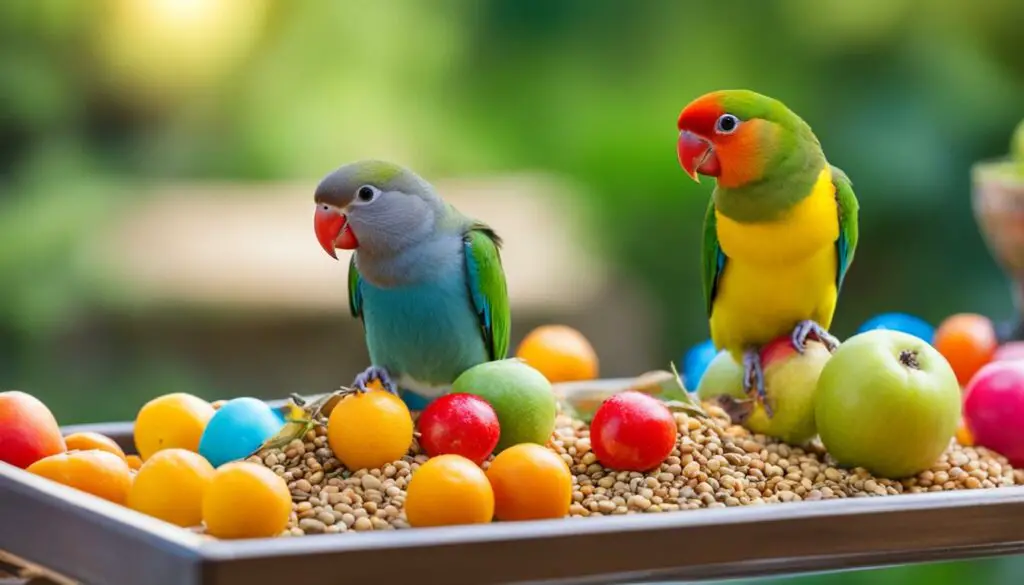
Lovebird Housing and Cage Requirements
When it comes to housing your lovebirds, it is important to provide them with a suitable cage that meets their needs for comfort, security, and plenty of space to move around. The size of the cage is crucial for their overall well-being, as lovebirds are active birds that require room to spread their wings and engage in natural behaviors.
For a pair of lovebirds, a minimum cage size of 32” x 20” x 20” is recommended. This will give them ample space to fly, climb, and play. It’s important to note that larger cages are always better, so if you have the space, opt for an even bigger cage to ensure your lovebirds can fully enjoy their environment.
When setting up the cage, provide a variety of perches at different heights to encourage exercise and foot health. It is also essential to include food and water dishes, as well as a bathing area for your lovebirds to keep themselves clean and healthy. Additionally, consider adding toys and enrichment items that will keep them mentally stimulated and entertained.
| Cage Size | Recommended Dimensions |
|---|---|
| Minimum Cage Size for a Pair of Lovebirds | 32” x 20” x 20” |
| Recommended Cage Size for Optimal Comfort | Bigger than 32” x 20” x 20” |
When deciding on the location for your lovebird’s cage, choose a spot that is well-lit and well-ventilated but away from direct sunlight and drafts. Lovebirds prefer a sense of security, so placing the cage close to a wall can help them feel more at ease. It’s also important to cover the cage at night to provide darkness and prevent disturbances, as lovebirds need a good night’s sleep.
While lovebirds may enjoy the presence of a nest box during breeding season, it is important to remove any eggs to prevent overpopulation. Breeding in lovebirds should be carefully planned and supervised by experienced bird owners.
Lovebird Social Behaviors
Lovebirds are highly social birds and form strong bonds with their mates or dedicated human companions. They engage in various social behaviors that reinforce their connection and communication with each other. Understanding these social behaviors is essential for providing the proper environment and care for your lovebird.
Lovebird Pair Bonding
Lovebirds are known for their strong pair bonding. Once they have formed a bond with a mate or human companion, they become deeply attached and loyal. They groom each other to maintain their plumage, feed each other as a sign of affection, and engage in mutual preening as a way to strengthen their bond. Pair bonding is crucial for the well-being of lovebirds, as it provides them with a sense of security and companionship.
Lovebird Flock Dynamics
Lovebirds are social birds that naturally live in flocks. Within a flock, they establish a hierarchy and rely on each other for protection and social interaction. When kept in pairs or small groups, lovebirds mimic this flock dynamic by forming their own social structure. They constantly interact with each other, communicate through vocalizations and body language, and engage in playful activities. Providing a social environment that allows lovebirds to interact with their own species or with dedicated human companions is crucial for their mental and emotional well-being.
Lovebird Loyalty
Lovebirds are known for their loyalty to their mates or human companions. Once they have formed a strong bond, they show unwavering devotion and trust. Lovebirds will often seek their bonded partner’s company, preferring to be close to them and engage in various activities together. They rely on their bonded pair or dedicated human companion for socialization, mental stimulation, and emotional support. Building a trusting relationship and providing consistent care and attention will help foster loyalty and strengthen the bond between you and your lovebird.
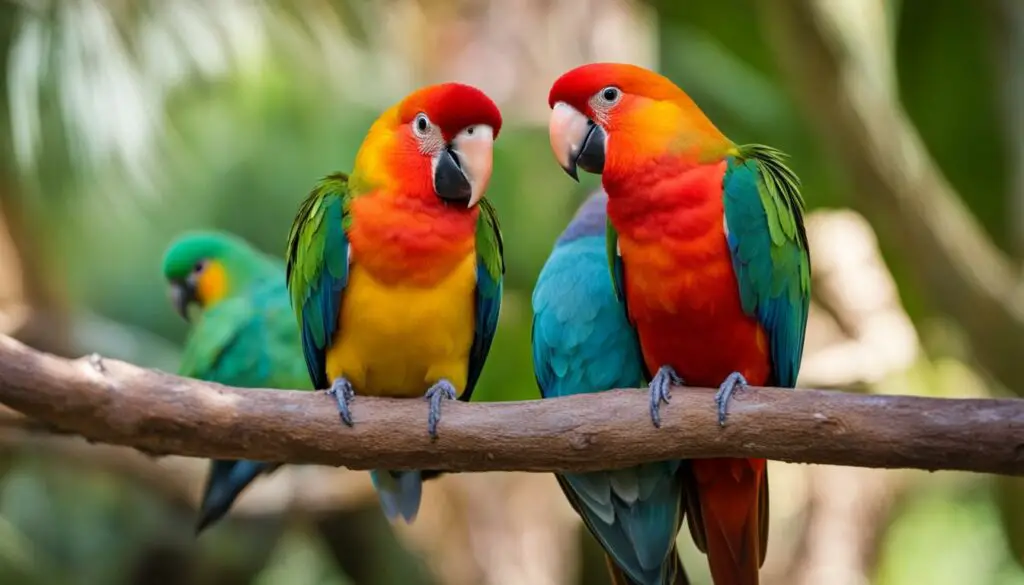
Table: Lovebird Social Behaviors
| Behavior | Description |
|---|---|
| Grooming | Lovebirds groom each other as a sign of affection and to maintain their plumage. |
| Feeding | Lovebirds feed each other to strengthen their bond and as a gesture of care. |
| Mutual Preening | Lovebirds engage in mutual preening to reinforce their bond and establish trust. |
| Vocalizations | Lovebirds communicate through various vocalizations to express their emotions and needs. |
| Body Language | Lovebirds use specific body positions and movements to convey their intentions and emotions. |
| Playful Activities | Lovebirds engage in playful activities together as a way to bond and have fun. |
Lovebird Handling and Training
Handling and training lovebirds is an important part of building a strong bond with these intelligent and affectionate birds. Patience and consistency are key when it comes to taming and training lovebirds.
When handling a lovebird, it’s important to start by building trust. Spend time near the bird’s cage, talking softly and making slow movements to avoid frightening them. Gradually introduce your hand by using a dowel as a perch, offering treats to coax the bird onto your finger. Remember to always respect the bird’s boundaries and allow them to approach you at their own pace.
Training lovebirds can be a rewarding experience. Positive reinforcement techniques, such as offering treats and verbal praise, are effective in teaching new behaviors. Target training and clicker training can also be used to establish communication and teach tricks. Remember to keep training sessions short, fun, and rewarding to keep the bird engaged.
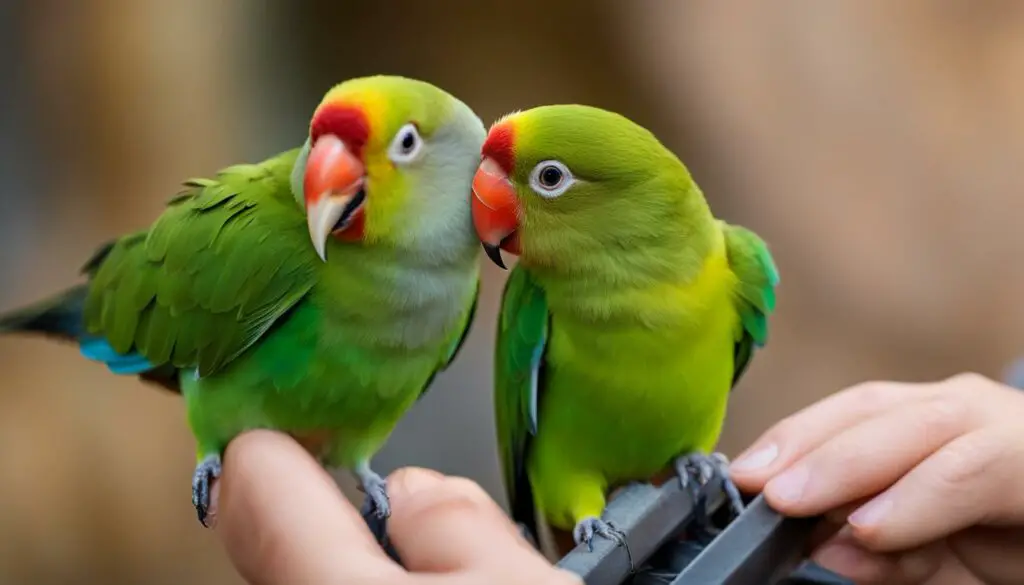
By investing time and effort into handling and training your lovebird, you can develop a strong bond and create a trusting relationship. Remember to always use gentle and positive methods, avoiding force or punishment. With patience and consistency, you can enjoy the rewards of a well-trained and well-behaved lovebird.
Lovebird Activities and Enrichment
Keeping lovebirds engaged and mentally stimulated is crucial for their overall well-being. Providing a variety of activities and enrichment can help prevent boredom and behavioral problems. Here are some ideas to keep your lovebirds entertained and happy:
1. Interactive Toys:
Lovebirds are intelligent birds that enjoy playing with toys. Choose toys that offer different textures, colors, and challenges to keep them engaged. Puzzle toys, foraging toys, and treat-dispensing toys are especially beneficial as they stimulate problem-solving skills and provide mental stimulation.
2. Playtime Outside the Cage:
Lovebirds love to explore their surroundings and bond with their human companions. Safely allow them to have supervised playtime outside the cage in a bird-proofed area. Provide perches, ladders, and toys to encourage exercise and exploration. Make sure there are no potential hazards such as toxic plants or open windows.
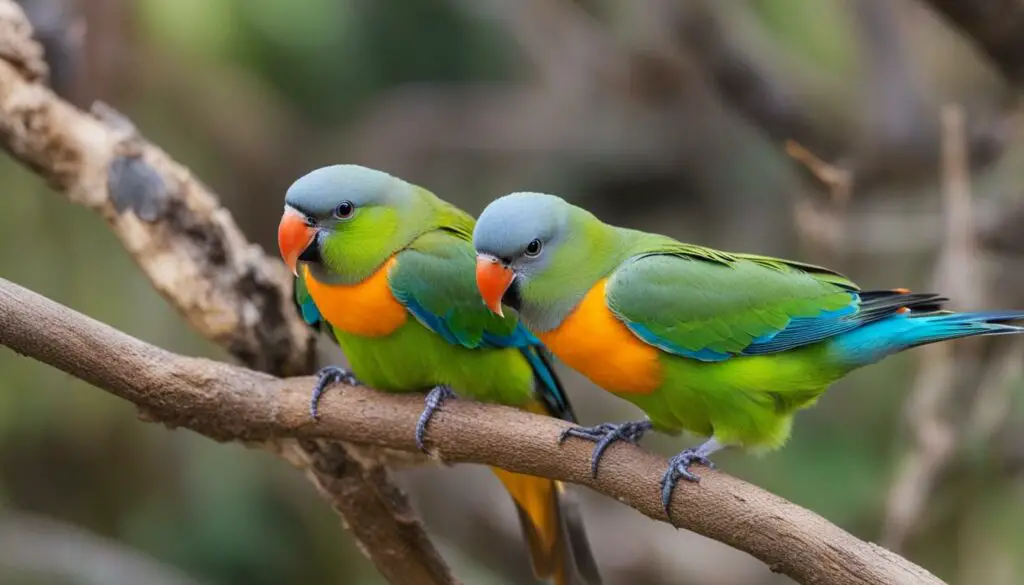
3. Social Interaction:
Lovebirds are social birds and enjoy spending time with their human companions. Interact with your lovebirds daily by talking to them, singing, or whistling. Offer treats as rewards for good behavior and positive interactions. Regular socialization helps strengthen the bond between you and your lovebirds.
Remember to always observe your lovebirds’ preferences and adjust the activities and enrichment accordingly. Each bird will have individual preferences, so it’s important to provide a variety of options and observe what they enjoy the most. Keeping lovebirds mentally and physically active will contribute to their overall well-being and happiness.
Lovebird Behavior Problems and Solutions
Understanding Lovebird Behavior Issues
Lovebirds, like any pets, can sometimes exhibit behavior problems that owners need to address. These issues can include aggression, hormonal behavior, excessive screaming, and biting. It’s important to understand that these behaviors are often a result of fear, stress, lack of socialization, or hormonal imbalances. By recognizing the underlying causes, you can take steps to resolve these problems and create a harmonious environment for your lovebird.
Addressing Aggression and Hormonal Behavior
Aggression in lovebirds can manifest as biting, lunging, or territorial behavior. It’s crucial to identify the triggers for your lovebird’s aggression and address them accordingly. Providing adequate socialization, mental stimulation, and a safe environment can help reduce aggressive tendencies. Hormonal behavior, such as excessive screaming or territoriality, can be managed through environmental modifications and maintaining a consistent routine. Creating a calm and secure space for your lovebird and avoiding physical contact during hormonal periods can also help alleviate these behaviors.
Managing Screaming and Biting
Screaming and biting are common issues that lovebird owners may face. Excessive screaming can be a sign of boredom, frustration, or attention-seeking behavior. To address this, provide your lovebird with plenty of mental and physical stimulation, such as toys and interactive playtime. Redirect their focus to more appropriate activities, and avoid reinforcing the screaming behavior by giving in to their demands. Biting, on the other hand, can be a defensive or territorial response. It’s important to establish boundaries, use positive reinforcement training techniques, and ensure that your lovebird feels safe and secure in their environment.
| Behavior Problem | Possible Causes | Solutions |
|---|---|---|
| Aggression | Fear, stress, lack of socialization, territoriality | Identify triggers, provide socialization, mental stimulation, and a safe environment |
| Hormonal Behavior | Hormonal imbalances, changes in season, breeding instincts | Modify the environment, maintain a consistent routine, and create a calm and secure space |
| Screaming | Boredom, frustration, attention-seeking | Provide mental and physical stimulation, redirect focus, avoid reinforcing the behavior |
| Biting | Defensive or territorial response | Establish boundaries, use positive reinforcement, ensure a safe and secure environment |
Seeking Professional Help
If your lovebird’s behavior problems persist or become unmanageable, it may be beneficial to seek professional help. An avian veterinarian or a professional bird behaviorist can provide expert advice and guidance tailored to your lovebird’s specific needs. They can help assess the underlying causes of the behavior problems and recommend appropriate solutions, such as behavior modification techniques or medication if necessary. Remember, patience and consistency are key when addressing behavior issues, and seeking professional assistance can greatly improve your lovebird’s quality of life.
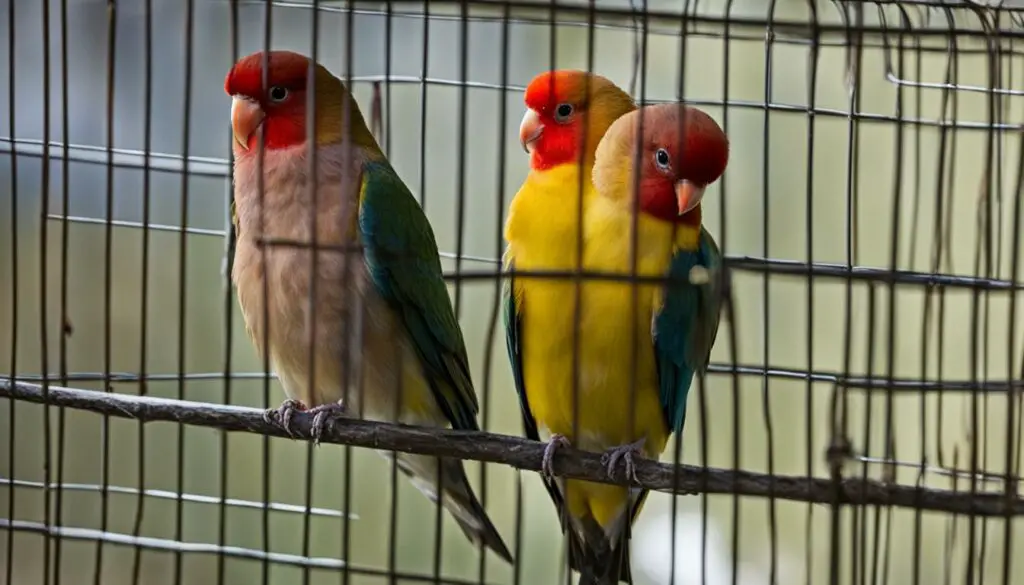
Lovebird Body Language and Communication
Understanding lovebird body language and communication is essential for building a strong bond with these intelligent and affectionate birds. Lovebirds use a combination of vocalizations and body movements to express their emotions and needs. By observing their behaviors, you can gain valuable insights into their well-being and establish a deeper connection with them.
Lovebird Vocalizations
Lovebirds are known for their wide range of vocalizations, which can vary from chirps and whistles to squawks and screeches. These vocalizations serve different purposes and can indicate various emotions. For example, cheerful singing and chirping are signs of happiness and contentment, while loud squawking may indicate fear, stress, or a need for attention. Understanding the context and frequency of these vocalizations can help you decipher what your lovebird is trying to communicate.
Lovebird Body Language
Lovebirds also communicate through their body language, using different postures and movements to convey their feelings. When a lovebird is relaxed and content, they may fluff out their feathers, close their eyes halfway, and bob their heads. On the other hand, signs of fear or discomfort can include flattened feathers, lowered head, wide eyes, and an open beak. It’s important to be attentive to these signals and provide a safe and secure environment for your lovebird to feel comfortable.
“Lovebirds communicate through a combination of vocalizations and body language. Understanding their body language can help interpret their emotions and needs.”
Signs of Happiness and Fear
Lovebirds exhibit specific behaviors that indicate their emotional state. Signs of happiness in lovebirds may include lively movements, such as jumping, wing flapping, and playful behavior. They may also engage in preening, grooming, and feeding each other, which are bonding activities that reflect their contentment. Conversely, signs of fear or threat in lovebirds can include aggression, such as biting or lunging, and defensive postures like fanning out their tail feathers or spreading their wings. Recognizing these signs can help you provide the necessary care and support to ensure your lovebird’s well-being.
| Lovebird Signs of Happiness | Lovebird Signs of Fear |
|---|---|
| Preening and grooming behaviors | Aggressive behaviors like biting or lunging |
| Playful movements and wing flapping | Defensive postures like fanning out tail feathers |
| Active vocalizations and cheerful chirping | Wide eyes, open beak, and flattened feathers |
By paying close attention to your lovebird’s body language, vocalizations, and overall behavior, you can better understand their needs and emotions. Creating a nurturing and supportive environment based on this understanding will help foster a strong bond and enhance the well-being of your lovebird.
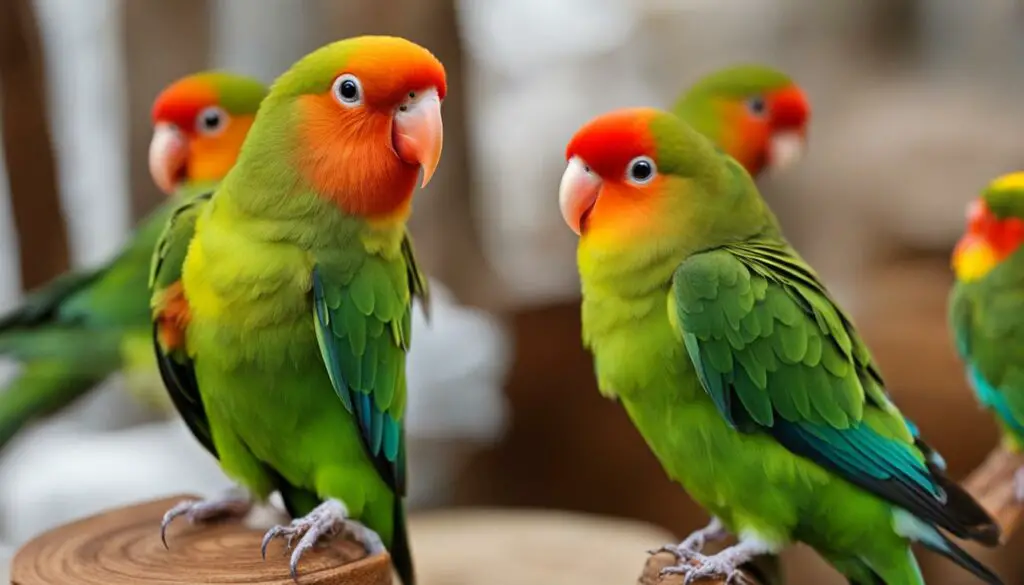
Lovebird Health and Wellness
Ensuring the health and wellness of your lovebird is crucial for their overall well-being. Regular monitoring and veterinary care are essential to detect any signs of illness early on. Common signs of illness in lovebirds include withdrawal, ruffled feathers, dull plumage, watery or dull eyes, runny nose, excessive sleep, loss of interest in the environment, and changes in droppings. If you notice any of these symptoms, it is important to seek veterinary care promptly.
Lovebirds are susceptible to various infectious diseases, respiratory ailments, parasites, and nutritional deficiencies. Visiting a veterinarian who specializes in avian care is recommended to ensure proper diagnosis and treatment. Regular check-ups are essential to monitor your lovebird’s health and address any potential issues before they become serious.
In addition to veterinary care, providing a balanced diet is crucial for maintaining your lovebird’s wellness. A combination of high-quality seeds, fresh fruits, vegetables, and supplements should be included in their daily diet. It is important to avoid feeding your lovebird avocado, as it can be toxic to them.
Creating a safe and clean living environment is also essential for your lovebird’s health. Regularly clean their cage, including perches, food and water dishes, and toys, to prevent the build-up of bacteria. Provide fresh water daily and use earthenware or porcelain dishes to avoid plastic ingestion. Maintaining proper hygiene and a stress-free environment will contribute to your lovebird’s overall wellness and happiness.
| Common Signs of Illness in Lovebirds | Preventive Measures |
|---|---|
| Ruffled feathers | Regular veterinary check-ups |
| Withdrawal | Proper nutrition |
| Dull plumage | Clean and safe living environment |
| Watery or dull eyes | Regular monitoring for changes in behavior or appearance |
| Runny nose | Prompt veterinary care for any signs of illness |
| Excessive sleep | Keep stress levels low |
| Loss of interest in the environment | Proper socialization and mental stimulation |
| Changes in droppings | Proper hygiene and cleanliness |
Proper Lovebird Veterinary Care
Regular veterinary care is essential for maintaining the health of your lovebird. Finding a veterinarian who specializes in avian care is recommended, as they will have the expertise and experience to provide the best care for your bird. During routine check-ups, the veterinarian will conduct a physical examination and observe your lovebird’s behavior and appearance. They may also recommend specific tests to check for any underlying health conditions.
It is important to establish a relationship with your avian veterinarian and follow their recommendations for preventative care. This may include vaccinations, deworming, and regular wellness exams. Your veterinarian can provide guidance on proper nutrition, hygiene practices, and environmental enrichment to ensure the overall well-being of your lovebird.
Remember, lovebirds are delicate creatures, and even minor changes in behavior or appearance can be a sign of illness. By staying vigilant and providing them with regular veterinary care, you can help ensure they live a long and healthy life.
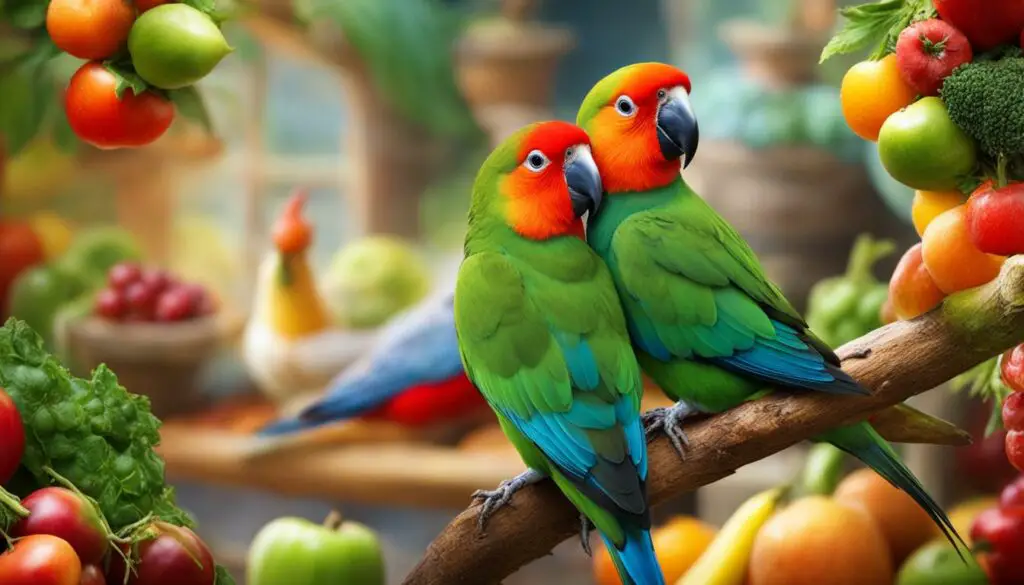
Lovebird Lifespan and Longevity
Lovebirds have an average lifespan of 10-12 years, but with proper care, some individuals can live even longer. Factors such as genetics, diet, veterinary care, and overall well-being can influence a lovebird’s longevity. Regular check-ups, a balanced diet, regular exercise, mental stimulation, and a stress-free environment contribute to their well-being and potential for a longer lifespan. Owners should be prepared for the commitment of caring for a lovebird for many years and provide the necessary resources to ensure their well-being throughout their entire lifespan.
Understanding lovebird lifespan and longevity is crucial for providing the best care and nurturing environment for these intelligent and affectionate birds. By implementing proper care and lifestyle practices, their lifespan can be extended, allowing for many years of companionship and joy.
Factors Affecting Lovebird Lifespan
- Genetics: Each lovebird has its genetic predisposition for lifespan, which can vary within the species. Some individuals may be more resilient and long-lived, while others may have a shorter lifespan due to genetic factors.
- Diet: Providing a balanced and nutritious diet is essential for lovebird health and longevity. A diet rich in fresh fruits, vegetables, seeds, and supplements ensures the necessary nutrients for their well-being.
- Veterinary Care: Regular check-ups with an avian veterinarian help detect and address any potential health issues early on, promoting overall wellness and longevity.
- Overall Well-being: Creating a stress-free environment, providing mental stimulation, and maintaining a consistent routine contribute to lovebird well-being, which in turn can affect their lifespan.
By prioritizing these factors and offering lovebirds a nurturing and enriching environment, owners can contribute to their longevity and ensure a happy and fulfilling life for these beloved pets.
| Factors | Impact on Lovebird Lifespan |
|---|---|
| Genetics | Variability in individual lifespans |
| Diet | Proper nutrition for optimal health |
| Veterinary Care | Early detection and treatment of health issues |
| Overall Well-being | Reducing stress and promoting mental stimulation |
By understanding the factors that influence lovebird lifespan and implementing the necessary care practices, owners can ensure that their feathered companions live a long and healthy life.
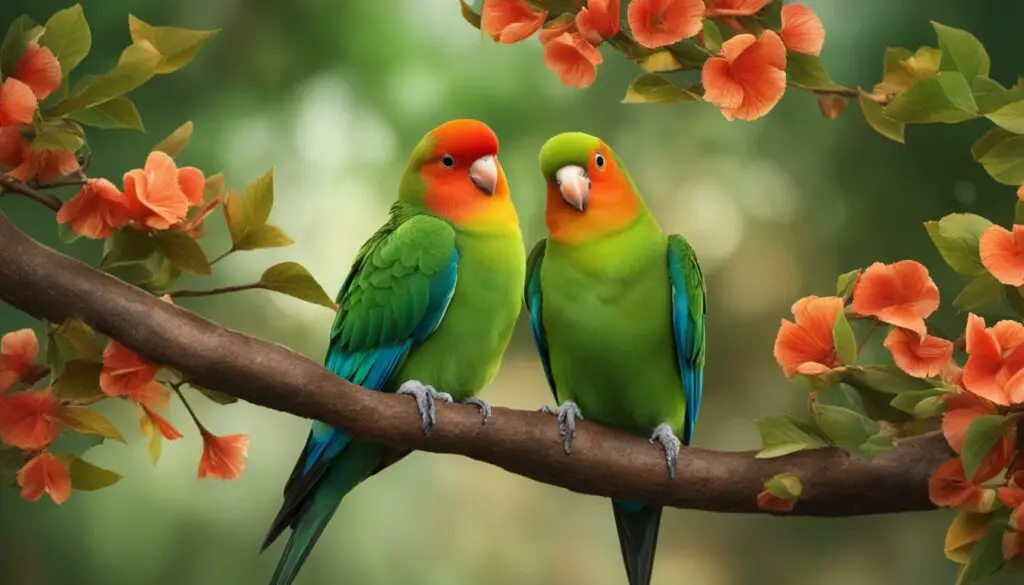
Lovebird Bonding Tips for Owners
Building a strong bond with your lovebird is essential for creating a trusting and fulfilling relationship. Here are some valuable tips to help you with lovebird bonding, socialization, trust-building, and companionship:
Spend Quality Time Together:
Devote regular time to interact and bond with your lovebird. This can include talking softly to them, offering treats, and engaging in activities that they enjoy. By dedicating quality time, you will strengthen the bond and create a sense of companionship.
Provide a Safe and Enriched Environment:
Ensuring your lovebird’s environment is safe and enriched is crucial for their well-being and bonding. Offer a spacious cage with plenty of perches, toys, and interactive puzzles to keep them mentally stimulated. Creating a secure and exciting space will contribute to their trust and happiness.
Respect Boundaries and Patience:
Each lovebird has their own personality and comfort level. It’s important to respect their boundaries and allow them to approach you at their own pace. Avoid sudden movements or loud noises that may startle or frighten them. Patience is key in building trust and gradually strengthening the bond.
Socialize with Other Humans and Birds:
Lovebirds benefit from socializing with both humans and other birds. Interacting with different people and exposing them to various environments can help them become well-adjusted and sociable. If you have multiple lovebirds, introducing them to each other in a supervised and controlled manner can also enhance their companionship.
By implementing these lovebird bonding tips, you can foster a deeper connection with your feathered companion, ensuring a happy and fulfilling relationship.
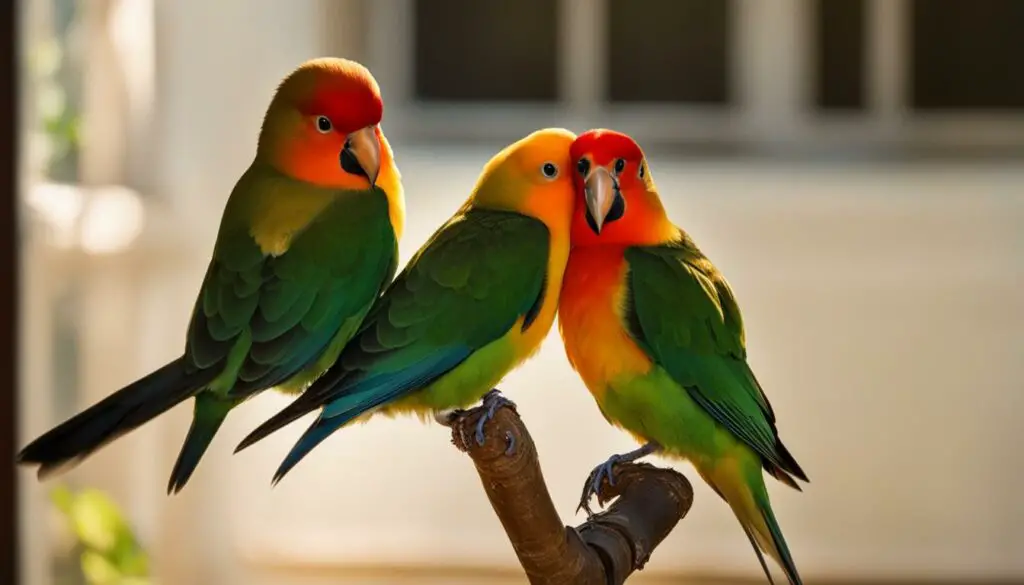
Lovebird Behavior Training and Modification
Training and modifying the behavior of lovebirds requires patience, consistency, and the use of positive reinforcement techniques. Lovebirds are intelligent birds that can learn and respond well to training when approached in a gentle and respectful manner.
One effective method for training lovebirds is target training. This involves using a small stick or dowel as a target for the bird to touch or follow with its beak. By rewarding the bird with a treat each time it successfully touches the target, you can reinforce the desired behavior and gradually shape it into more complex actions.
Another popular training technique is clicker training. This involves using a clicker, a small device that makes a clicking sound, to mark the desired behavior and immediately follow it with a reward. The clicker serves as a clear and consistent signal to the bird that it has performed the desired action correctly.
| Training Technique | Description |
|---|---|
| Target Training | Using a stick or dowel as a target for the bird to touch or follow with its beak, rewarding it with a treat for each successful interaction. |
| Clicker Training | Using a clicker to mark the desired behavior and immediately following it with a reward, helping the bird understand which actions are desired. |
| Positive Reinforcement | Rewarding the bird with treats, praise, or affection whenever it exhibits a desirable behavior, encouraging it to repeat the behavior in the future. |
| Patient and Consistent Approach | Using a calm and consistent approach to training, allowing the bird to progress at its own pace and reinforcing good behavior consistently over time. |
Positive reinforcement is key to successful behavior training and modification. By rewarding your lovebird with treats, praise, or affection whenever it exhibits a desirable behavior, you can motivate and encourage the bird to repeat the behavior in the future. It’s important to be patient and consistent in your approach, allowing the bird to progress at its own pace and reinforcing good behavior consistently over time.
Remember that every lovebird is unique, and it’s important to tailor your training techniques to the individual bird’s needs and personality. If you’re experiencing challenges or need additional guidance, consider consulting with a professional bird trainer or behaviorist who can provide expert advice and support.
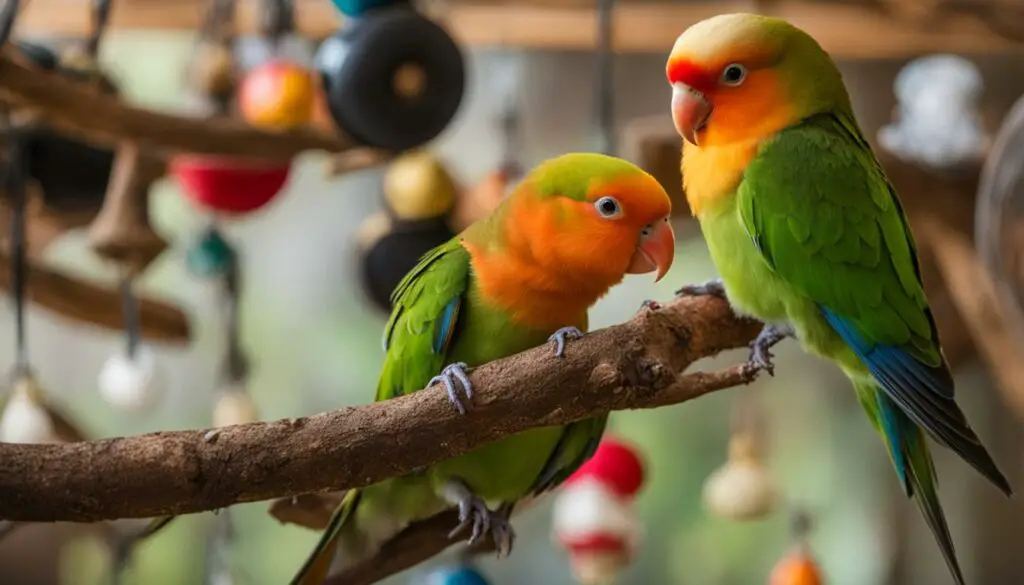
Conclusion
Understanding lovebird bonding and behavior is essential for providing a happy and fulfilling life for these intelligent and affectionate birds. Creating a suitable social environment, meeting their physical and emotional needs, and establishing a strong bond through trust and positive reinforcement training are crucial for their well-being.
Regular veterinary care, proper nutrition, mental stimulation, and a safe living environment contribute to their overall health and longevity. With love and patience, lovebirds can be delightful companions and bring joy to their owners for many years.
FAQ
Are lovebirds social birds?
Yes, lovebirds are highly social birds and thrive when they have a bonded pair or a dedicated human companion.
What should I feed my lovebird?
Lovebirds require a balanced diet consisting of seeds, fruits, vegetables, and supplements to ensure proper nutrition.
How should I set up my lovebird’s cage?
It is important to provide a large and well-ventilated cage with plenty of space, perches, and food and water dishes for your lovebird’s well-being.
Can lovebirds be aggressive?
Lovebirds can exhibit aggression, especially towards other birds. They are best kept as pairs or with dedicated human companions.
How do I tame and train my lovebird?
Taming and training a lovebird requires patience, consistent effort, and using positive reinforcement techniques. It is important to avoid force or punishment.
What kind of toys should I provide for my lovebird?
Lovebirds require mental and physical stimulation, so provide a variety of toys such as seed bells, swings, ladders, and interactive puzzles.
What should I do if my lovebird exhibits behavior problems?
Addressing behavior problems in lovebirds requires identifying the underlying cause and implementing appropriate solutions. Consulting with a professional may be necessary.
How can I understand my lovebird’s body language?
Lovebirds communicate through a combination of vocalizations and body language. Understanding their body language can help interpret their emotions and needs.
How do I ensure my lovebird’s health and wellness?
Regular monitoring, proper diet, clean housing, and regular veterinary care are essential for ensuring your lovebird’s health and well-being.
What is the average lifespan of a lovebird?
Lovebirds have an average lifespan of 10-12 years, but with proper care, some individuals can live even longer.
How can I build a strong bond with my lovebird?
Building a strong bond with a lovebird requires time, patience, and understanding. Spending quality time together, talking softly, and providing a safe environment are important.
Can lovebirds be trained to exhibit desired behaviors?
Yes, lovebirds can be trained to exhibit desired behaviors through positive reinforcement techniques. Training sessions should be short, fun, and rewarding for the bird.

